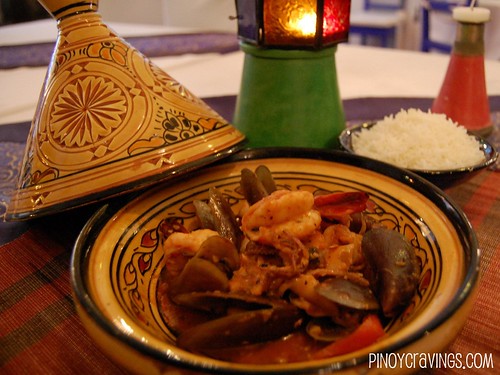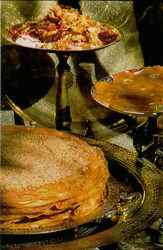Cuisine of Morocco

Moroccan cuisine is extremely diverse, thanks to Morocco's interaction with other cultures and nations over the centuries. Moroccan cuisine has been subject to Amazigh (Berber), Moorish,and Arab influences. The cooks in the royal kitchens of Fez, Meknes, Marrakesh, Rabat and Tetouan refined it over the centuries and created the basis for what is known as Moroccan cuisine today.
Morocco is rated amongst the best in the world for its cuisine. Here we give you a taste of the wealth of Moroccan flavours that await you.






 The strong Arab influence found in two of the royal cities, Fez and Marrakech, contributed greatly to Moroccan cuisine, as did the Andalusian sensibilities of Tetuan and the Jewish traditions from the coastal city of Essaouira. Aspects of all of these cultures can be found in four of the best-loved Moroccan dishes: couscous, plumped semolina grains which are served with a variety of toppings; bisteeya, a delectable three-layer pie which is both savory and sweet and wrapped in the thinnest of pastry; mechoui, tender roasted lamb; and djej emshmel, succulent roasted chicken cooked with olives and lemon.
The strong Arab influence found in two of the royal cities, Fez and Marrakech, contributed greatly to Moroccan cuisine, as did the Andalusian sensibilities of Tetuan and the Jewish traditions from the coastal city of Essaouira. Aspects of all of these cultures can be found in four of the best-loved Moroccan dishes: couscous, plumped semolina grains which are served with a variety of toppings; bisteeya, a delectable three-layer pie which is both savory and sweet and wrapped in the thinnest of pastry; mechoui, tender roasted lamb; and djej emshmel, succulent roasted chicken cooked with olives and lemon.
While spices have been imported to Morocco for thousands of years, many commonly-used raw ingredients are home-grown: mint and olives from Meknes, oranges and lemons from sunny Fez, prickly pear from Casablanca and shad from the Sebou river. Also cultivated in Morocco are pomegranates, almonds, dates, walnuts, chestnuts, honey, barley, cherries and melon. Seafood is abundant along the Atlantic coast while lamb and poultry are raised on higher ground.
The Moroccans are quick to point out that the best meals are found not in the restaurants but in the homes. In this land of good and abundant food, the emphasis is clearly on preparing your own. It is worth mentioning that women do virtually all of the cooking in this very traditional country.
For Moroccans, a special meal means extensive preparation: a banquet for important guests may take a week to prepare and is overseen by the host and his sons with no women being present. The men squat on cushions around low, artistically laid tables and a silver ewer of perfumed water is taken around and poured over three fingers of the right hand of each guest before the meal starts and on finishing. There may be up to 50 different courses.
Usually it is the ladies of the house who cook the meals and they spend hours in the preparation. Again, there are no chairs but rolled carpets or cushions that serve as seats. The ladies dress in long colourful robes.
Every household in Morocco makes their own bread which is made from semolina flour. When the bread has been kneaded and shaped each family puts its own mark on it before sending it to the bakery for cooking.
A typical family meal starts with Bstilla which is a crisp pastry, rolled until it is extremely thin and filled with chicken in a mixture of a sweet and peppery sauce.
Next comes a typical brochette or kebab which is flavoured with beef or lamb fat. Following would be a Tajine which is chicken or a meat in a spicy stew which had been simmering for hours and served with bread. Next comes a course of Batinjaan, an eggplant or tomato salad.
Couscous, the national dish of Morocco, would then be served with meat and vegetables followed by slices of melon or fruit and pastries made with honey and almonds. Mint tea is then served at the end of the meal.
Key Ingredients in Moroccan Cuisine
Moroccan cuisine is rich in spices which only natural when you consider the spice trade from Arabia to North Africa. Spices here are used to enhance and not mask the flavour of food. The following spices are among the most commonly used.
Cinnamon – which is found in Bisteeya, Couscous and many desserts
Cumin - ground cumin is among the most highly flavoured spice used and is common in meats, lamb and chicken
Turmeric - always found in Harira soup which is a soup drunk for the evening meal during Ramadan
Ginger - found in many stews
Paprika - usually in tomato and vegetable dishes
Anise seed - found in breads and cookies
Sesame seed - used in breads and desserts
Cuisine Traditions & Recipes


A Taste of Morocco Travel: The World of Moroccan Cuisine
Moroccan cuisine is the culinary star of North Africa. Imperial and trade influence has been filtered and blended into Morocco's culture. Being at the crossroads of many civilizations, the cuisine of Morocco is a mélange of Arab, Berber, Moorish, French, Middle Eastern, Mediterranean African, Iberian, and Jewish influences. Moroccan cooking is enhanced with fruits, dried and fresh -- apricots, dates, figs, and raisins, to name a few. Lemons preserved in a salt-lemon juice mixture bring a unique face to many Moroccan chicken and pigeon dishes. Nuts are prominent; pine nuts, almonds, and pistachios show up in all sorts of unexpected places. Moroccan sweets are rich and dense confections of cinnamon, almond, and fruit perfumes that are rolled in filo dough, soaked in honey, and stirred into puddings. The cooks in the royal kitchens of Fes,Meknes, Marrakech, Rabat and Tetouan refined Moroccan cuisine over the centuries and created the basis for what is known as Moroccan cuisine today. Spices are used extensively in Moroccan food. While spices have been imported to Morocco for thousands of years, many ingredients, like saffron from Taliouine, mint and olives from Meknes, and oranges and lemons from Fes, are home-grown. Common spices include karfa (cinnamon), kamoun (cumin), kharkoum (turmeric), skingbir (ginger), libzar (pepper) , tahmira (paprika), anis seed, sesame seed, kasbour (coriander), maadnous (parsley), zaafrane beldi (saffron) and mint.

TAJINE
A classic dish prepared in an earthenware pot that combines meat, fruit and spices.

COUSCOUS
The national dish of Morocco, eaten on Fridays, at weddings, funerals and on Ramadan.

BREADS
Assorted breads of barley and semolina are baked from scratch by women in earthen ovens.

DESERTS & PASTRIES
Moroccan sweets are made with nuts, honey and cinnamon in all shapes, sizes and textures.

WINES & BEER
Morocco is a leading wine producer of bold red and whites popular among Westerners.

JUICES
Morocco's gardens produce oranges, apples, bananas, plums and pomegranates used in fruit and nutbased drinks.

FRUITS & NUTS

ARABIC COFFEE
Morocco has an Arabic coffee making culture reminiscent to that of Europe.

MINT TEA
Mint tea, the national Moroccan drink is served in homes, markets and at celebrations.

SPICES
Spices are essential to Moroccan cooking and known for their medicinal valu
